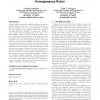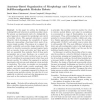9 search results - page 1 / 2 » Evolution of functional specialization in a morphologically ... |
GECCO
2009
Springer
13 years 11 months ago
2009
Springer
A central tenet of embodied artificial intelligence is that intelligent behavior arises out of the coupled dynamics between an agent’s body, brain and environment. It follows t...
CIRA
2007
IEEE
13 years 11 months ago
2007
IEEE
— The results presented in this paper are a part of the second phase of a body of research with the goal of coevolving the mind and morphology of dynamic robots. We use a 3-Dimen...
ALIFE
2000
13 years 4 months ago
2000
The evolution of simulated robots with three different architectures is studied in this article. We compare a nonmodular feed-forward network, a hardwired modular, and a duplicatio...
NCA
2010
IEEE
12 years 11 months ago
2010
IEEE
In this paper we address the challenge of realizing full-body behaviors in scalable modular robots. We present an experimental study of a biologically inspired approach to organize...
CONNECTION
2004
13 years 4 months ago
2004
The Artificial Life approach to Evolutionary Robotics is used as a fundamental framework for the development of a modular neural control of autonomous mobile robots. The applied e...


